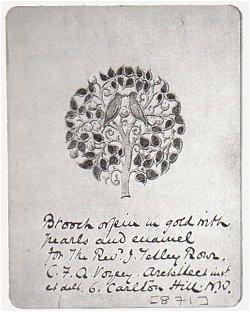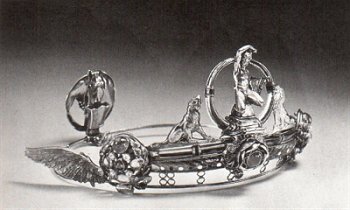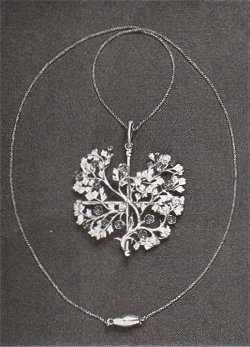A loupe’s view of the many eccentric, beautiful pieces of jewellery on view at the auction houses.

C.F.A. Voysey’s bird design for a brooch.
In the sale-rooms, there are stones galore in the offing this month and next: diamonds that glitter with a pure white intensity, sapphires in whose blue we learn to speak the truth, emeralds that glow like the end of the ages, and rubies that flame like our unspoken lusts will all be on sale at Sotheby’s on 25 March, and at Christie’s on 19 April. Perfect stones are fascinating. David Bennett, FGA, the charming director of the Sotheby’s Jewellery Department, speaks of his Sotheby’s compeers who scoff at the jewellery sales, persuaded that to negotiate the sale of anything that is not great art is to be virtually a tradesman. But David Bennett finds in perfect pieces of jewellery an “approximation of perfection,” which, he maintains, thrills anyone who ventures into his department. Indeed, even the most reputable specialists apparently want to touch, handle, try on the finest pieces. The purity of a pure stone is something unknown in the fine arts; there is no such thing as a pure and perfect watercolour. The settings for such specimens of nature’s triumph over art can be touching in their reverence or magnificent in their spirited attempt to warrant such beauty as they have shared.
Value, increasingly, lies not in the actual worth of the stones, but in the design value of the settings. The recognisable styles of the houses of the Twenties and Thirties have all but gone, and the generic jewellery from the shops in the high street of today is somehow not very thrilling to most connoisseurs. The whimsy, the delicacy, the sense of high elegance the sense of humour which invest much nineteenth- and early-twentieth-century jewellery with its glint of the fabulous is virtually unknown in our time. David Bennett speaks with comely distaste of jewellery that is meant to show wealth — a notion he suggests reached its peak in the Seventies — and with warm enthusiasm of the fine sense of spectacle which flourished when restraint could be the most formidable sort of glamour.

Orpheus tiara (with detachable fig-leaf for the central figure), designed by Henry Wilson in enamelled gold and rock crystal with cabochon sapphires.
This month, at Wartski, 14 Grafton Street, W1, there is an exhibition to celebrate the publication of Charlotte Gere and Geoffrey Munn’s new book on jewellery in art. The exhibition includes such spectacular loan pieces as the Queen Mother’s jewel casket, the Marquess of Bute’s marriage jewellery, and additional loans from the Duke of Devonshire, the Duke of Marlborough, the Victoria & Albert Museum, the Fitzwilliam, and the Ashmolean. About 10 per cent of the works included in the exhibition are for sale. These are pieces designed by Pre-Raphaelites, pieces associated with prominent Victorians, pieces with some interest and significance outside the realm of the ordinary. So we find an assortment of enamelled brooches with neo-Egyptian motifs, which one would think more likely to suit Nefertiti than to suit a Victorian noblewoman; strange floral tributes to the dead the dying; great necklaces that look like stage props or like armour; and beautiful and delicate studies in gold and crystal and precious stones.
Among the most glorious pieces in the exhibition is a tiara designed by Henry Wilson for Lady Llewelyn-Smith to wear for her début, to be presented before Queen Alexandra. The tiara is a wonder of rock crystal and cabochon sapphires, and features a winged hat to hold the inevitable ostrich plumes at the back; in thr front, the naked figure of Orpheus is flanked by two sinewy golden lions. Orpheus, his body taut, one arm raised dramatically above his head, his knees thrust forth as though in the ecstasy of physical motion, has a certain suggestive quality about him. And Lady Llewelyn-Smith apparently felt some concern about the Queen’s response to this bit of drama; she asked Wilson to make her a detachable fig-leaf, a sort of clip-on loincloth to wear at court. How often, and on what occasions, she wore the tiara after her presentation is sadly not recorded; certainly one cannot escape the image of her preparing for an evening out, trying to decide whether it was a fig-leaf evening or an evening of caution thrown to the winds.

Arthur Severn’s Whiteland’s cross, commissioned by John Ruskin.
Also in the sale are two versions of the Whitelands cross, which John Ruskin commissioned for presentation to the May Queen at the graduation ceremonies of a teacher-training college. The cross is still presented to each year’s May Queen, who is still a girl elected by her peers for her matchless beauty, constant good grace, and endearing kindness. The cross was in memory of Rose La Touche, with whom Ruskin had a notorious non-affair for rather a long time, and whose May Queenish qualities he apparently wished to celebrate after she was gone. In 1883, he commissioned a cross from Burne-Jones, and this one is in the exhibition; unfortunately, it was not well-received at the time. The father of the May Queen of 1883 maintained that Burne-Jones had been wildly inaccurate in his depiction of the hawthorn which makes the cross; Ruskin, daunted, wrote a furious letter to Burne-Jones, and gave the commission the following year to Arthur Severn. The Severn cross is also in the exhibition.
There’s more luxury to come at the sale-rooms: on 31 May, Sotheby’s will add to the usual springtime sale of marine and nautical objects a selection of period yachts, all with exquisite interior appointments, running the gamut from £15,000 to several million pounds. The yachts will be on view in Florida, the South of France, Monte Carlo, the West Indies, and other such traditional yachting spots; Sotheby’s is breaking new ground with this ale, creating a new market-place for period yachts. The sale will take place in London, with the yachts on video for the edification of the bidders.
New masters
At Christie’s, South Kensington, on 14 March, there will be a sale of “new contemporaries” — artists whose work has no established market value. Though work by unknown artists was sold at the Sotheby’s sale in Moscow last year quite successfully, the idea of using a sale not to recognise but to establish the reputations and market values of the works of new young artists is really a first for Christie’s. The estimates run from £100 to £900 — but, we are told firmly, “it is the public who will decide the worth of each painting.” Is the public qualified to make such decisions? Only time will tell.











